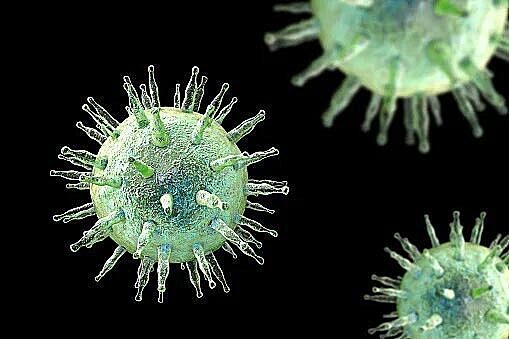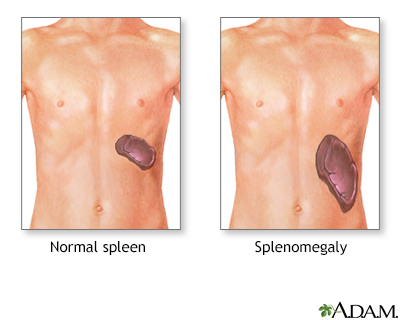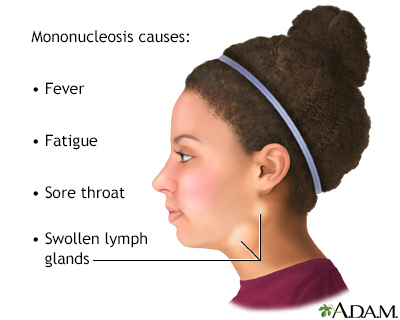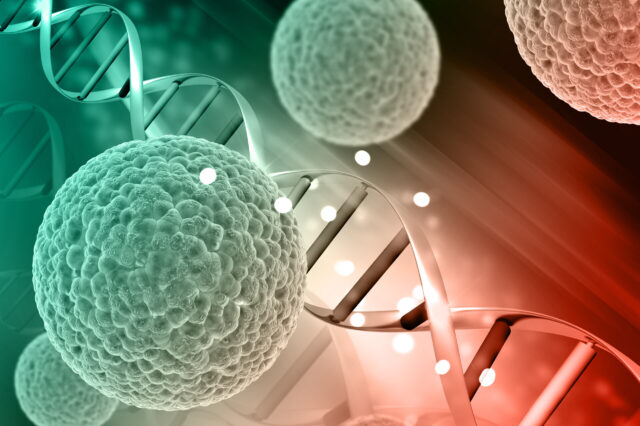Definition
Mononucleosis, or mono, is a viral infection that causes fever, sore throat, and swollen lymph glands, most often in the neck.
Alternative Names
Mono; Kissing disease; Glandular fever
Causes
Mono is often spread by saliva and close contact. It is known as "the kissing disease." Mono occurs most often in people ages 15 to 17, but the infection may develop at any age.
Mono is caused by the Epstein-Barr virus (EBV). Rarely, it is caused by other viruses, such as cytomegalovirus (CMV).
Symptoms
Mono may begin slowly with fatigue, a general ill feeling, headache, and sore throat. The sore throat slowly gets worse. Your tonsils become swollen and develop a whitish-yellow covering. Often, the lymph nodes in the neck are swollen and painful.
A pink, measles-like rash can occur, and is more likely if you take the medicine ampicillin or amoxicillin for a throat infection. (Antibiotics are typically not given without a test that shows you have a strep infection.)
Common symptoms of mono include:
Less common symptoms are:
Exams and Tests
Your health care provider will examine you. They may find:
- Swollen lymph nodes in the front and back of your neck
- Swollen tonsils with a whitish-yellow covering
- Swollen liver or spleen
- Skin rash
Blood tests will be done, including:
- White blood cell (WBC) count -- will be higher than normal if you have mono
- Monospot test -- will be positive for infectious mononucleosis
- Antibody titer -- tells the difference between a current and past infection
Treatment
The goal of treatment is to relieve symptoms. Steroid medicine (prednisone) may be given if your symptoms are severe.
Antiviral drugs, such as acyclovir, have little or no benefit.
To relieve typical symptoms:
- Drink plenty of fluids.
- Gargle with warm salt water to ease a sore throat.
- Get plenty of rest.
- Take acetaminophen or ibuprofen for pain and fever.
Also avoid contact sports if your spleen is swollen (to prevent it from rupturing).
Outlook (Prognosis)
The fever usually drops in 10 days, and swollen lymph glands and spleen heal in 4 weeks. Tiredness usually goes away within a few weeks, but it may linger for 2 to 3 months. Nearly everyone recovers completely.
Possible Complications
Complications of mononucleosis may include:
- Anemia, which occurs when red blood cells in the blood die sooner than normal
- Hepatitis with jaundice (more common in people older than 35)
- Swollen or inflamed testicles
- Nervous system problems (rare), such as Guillain-Barré syndrome, meningitis, seizures, damage to the nerve that controls movement of the muscles in the face (Bell palsy), and uncoordinated movements
- Spleen rupture (rare, avoid pressure on the spleen)
- Skin rash (uncommon)
Death is possible in people who have a weakened immune system.
When to Contact a Medical Professional
The early symptoms of mono feel very much like any other illness caused by a virus. You do not need to contact a provider unless your symptoms last longer than 10 days or you develop:
- Abdominal pain
- Breathing difficulty
- Persistent high fevers (more than 101.5°F or 38.6°C)
- Severe headache
- Severe sore throat or swollen tonsils
- Weakness in your arms or legs
- Yellow color in your eyes or skin
Call 911 or the local emergency number or go to an emergency room if you develop:
-
Sharp, sudden, severe abdominal pain
-
Stiff neck or severe weakness
-
Trouble swallowing or breathing
Prevention
People with mono may be contagious while they have symptoms and for up to a few months afterwards. How long someone with the disease is contagious varies. The virus can live for several hours outside the body. Avoid kissing or sharing utensils if you or someone close to you has mono.
References
Ebell MH, Call M, Shinholser J, Gardner J. Does this patient have infectious mononucleosis?: the rational clinical examination systematic review. JAMA. 2016;315(14):1502-1509. PMID: 27115266 pubmed.ncbi.nlm.nih.gov/27115266/.
Johannsen EC, Kaye KM. Epstein-Barr virus (infectious mononucleosis, Epstein-Barr virus-associated malignant diseases, and other diseases). In: Bennett JE, Dolin R, Blaser MJ, eds. Mandell, Douglas, and Bennett's Principles and Practice of Infectious Diseases. 9th ed. Philadelphia, PA: Elsevier; 2020:chap 138.
Weinberg JB. Epstein-Barr virus. In: Kliegman RM, St. Geme JW, Blum NJ, Shah SS, Tasker RC, Wilson KM, eds. Nelson Textbook of Pediatrics. 21st ed. Philadelphia, PA: Elsevier; 2020:chap 281.
Winter JN. Approach to the patient with lymphadenopathy and splenomegaly. In: Goldman L, Schafer AI, eds. Goldman-Cecil Medicine. 26th ed. Philadelphia, PA: Elsevier; 2020:chap 159.












